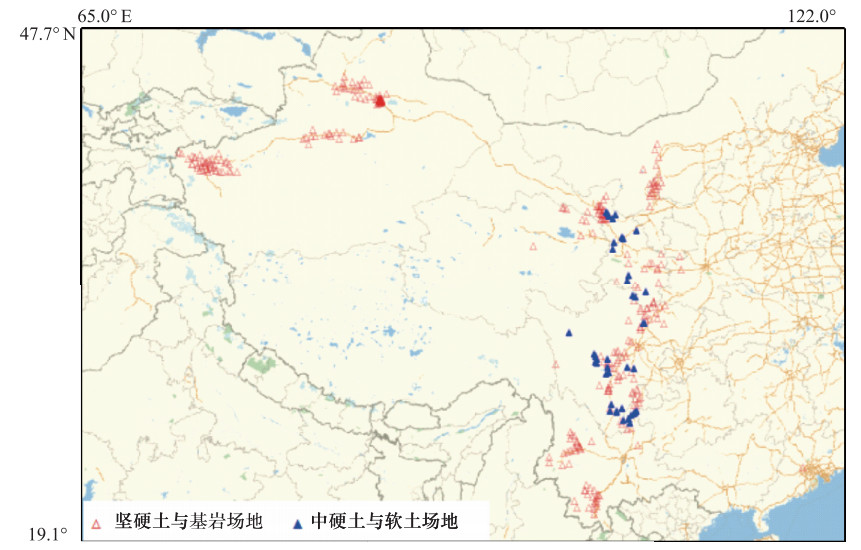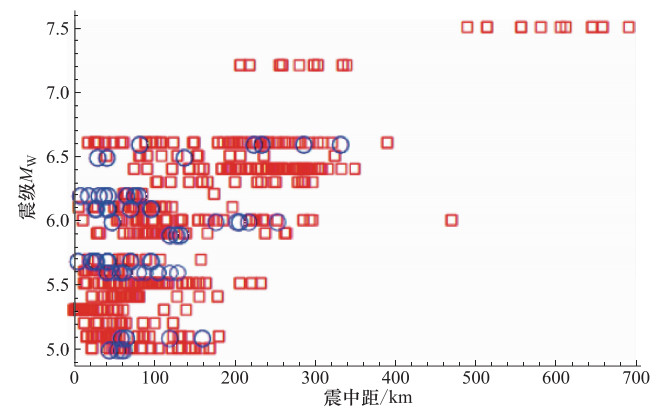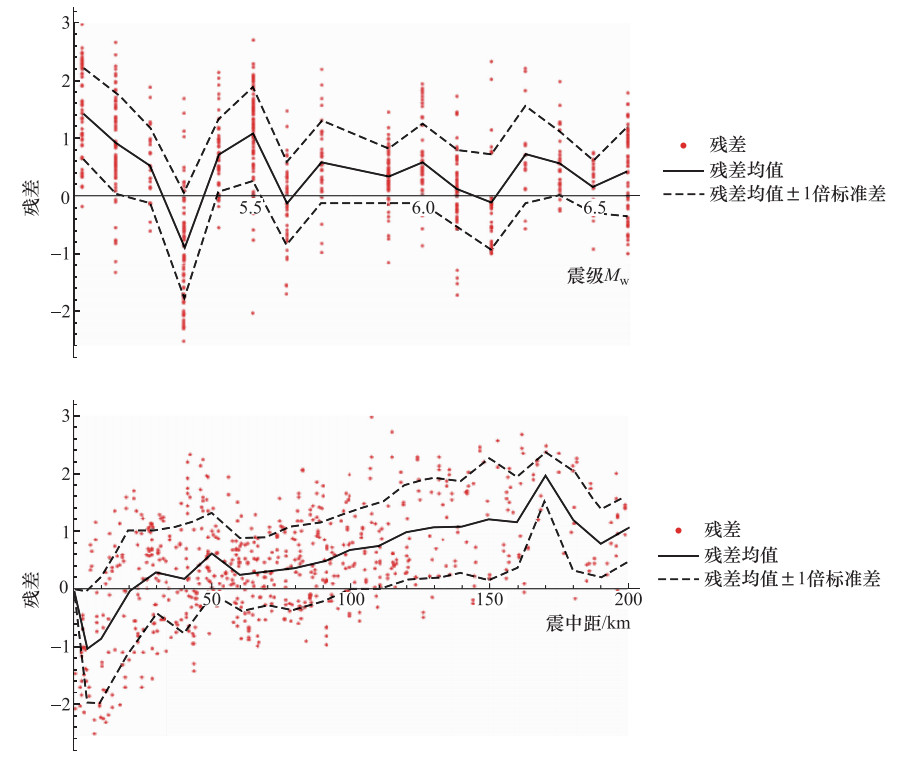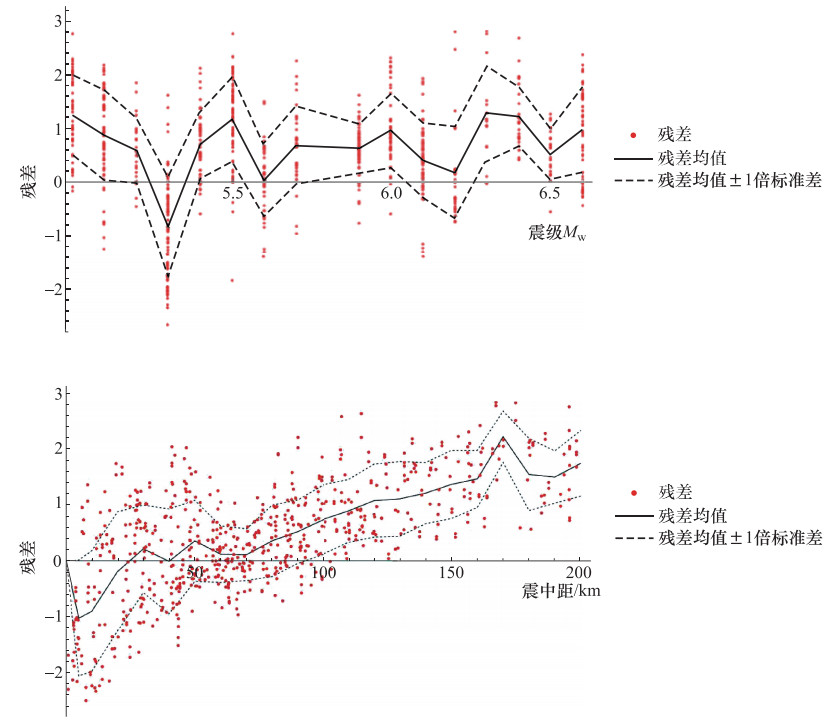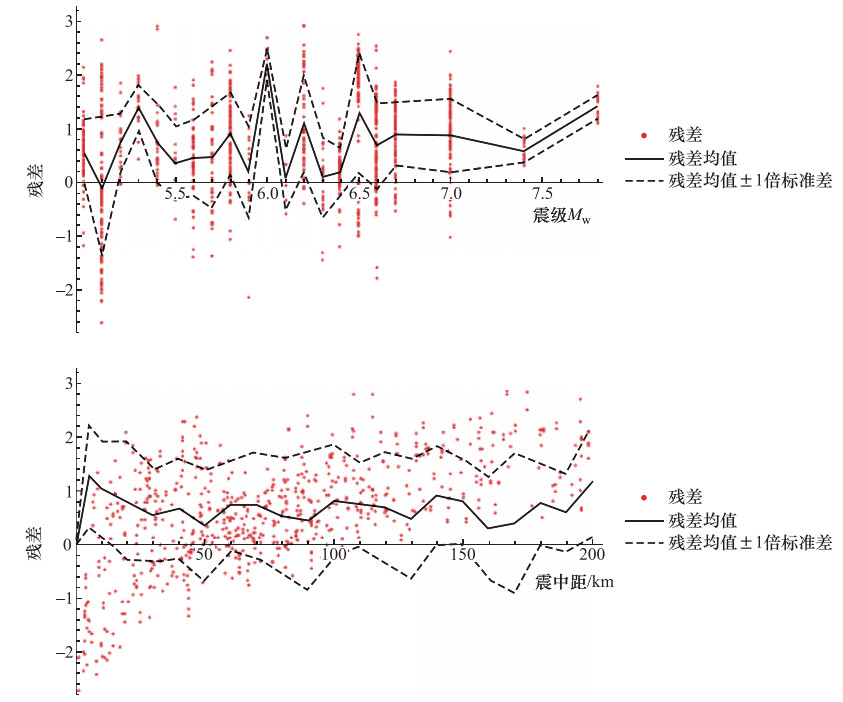Analysis and Application of Attenuation Relationships for Peak Accelerations of Ground Motion in Western China
-
摘要: 地震动参数衰减关系描述了地震动参数随震级和距离等因素的变化情况,选取合适的地震动衰减关系是地震危险性分析中确定工程场地地震动参数的关键环节。本文收集、整理和分析了中国西部地区2012年3月9日—2017年9月16日间发生的42次地震事件中获取的强震动记录资料,并选择了3个国际上基于不同地区强震动记录数据建立的地震动加速度衰减关系(ASB11、SCEMY97和LLCS11),开展了加速度衰减关系计算结果与中国西部强震动记录值的对比研究。比较了衰减关系峰值加速度的预测中值与实际记录值之间的差异,并分析了其残差随震级和距离的变化。得到了以下结论:①相比于SCEMY97和LLCS11,ASB11更适合于中国西部地区;②研究中国西部地区的衰减关系时,有必要考虑高频地震动的震级饱和现象。同时,对于如何修正已有衰减关系以使其更适合于中国西部地区给出了相应的建议。Abstract: The ground motion attenuation relationship depicts how ground motion parameters vary with factors such as magnitude and distance. It is critical to choose an appropriate attenuation relationship in determining the ground motion parameters for engineering sites in seismic hazard analysis. In this study, ground motion records from 42 earthquake events happened from 9 March 2012 to 16 September 2017 in western China were collected, sorted and analyzed. Three attenuation relationships for peak accelerations (ASB11, SCEMY97, LLCS11) worldwide, built with data from different regions, were compared with these record data. Through comparing the peak accelerations calculated by the three chosen attenuation relationships with the recorded peak accelerations, and analyzing the relationships between residuals and magnitude and distance, we conclude out that ① ASB11 works better for western China than SCEMY97 and LLCS11; ② the magnitude saturation of high-frequency ground motions needs to be considered in developing attenuation relationship for western China. Moreover, suggestions were made on the revision of the attenuation relationships so that they might work better for western China.
-
Key words:
- Western China /
- Attenuation relationship /
- Peak acceleration /
- MW /
- Epic-center distance
-
表 1 地震事件基本信息
Table 1. Basic information of earthquake events
事件编号 地震时间 纬度/°N 经度/°E 矩震级MW 1 2012年3月9日6:50 39.4 81.3 5.9 2 2012年9月7日11:19 27.5 104 5.6 3 2013年1月18日20:42 31 99.4 5.6 4 2013年3月3日13:41 25.9 99.7 5.4 5 2013年3月11日11:01 40.2 77.5 5.2 6 2013年3月29日13:01 43.4 86.8 5.4 7 2013年4月17日9:45 26.9 99.8 5.3 8 2013年4月20日8:02 30.3 103 6.6 9 2013年7月22日7:45 34.5 104.2 6.0 10 2013年8月30日13:27 43.8 87.6 5.3 11 2013年9月20日5:37 37.7 101.5 5.1 12 2014年5月24日4:49 25 97.8 5.7 13 2014年5月30日9:20 25 97.8 5.9 14 2014年7月9日5:52 39.3 78.3 5.0 15 2014年8月3日16:30 27.1 103.3 6.2 16 2014年8月17日6:07 28.1 103.5 5.1 17 2014年10月2日23:56 36.4 97.8 5.2 18 2014年10月7日21:49 23.4 100.5 6.1 19 2014年11月22日16:55 30.26 101.69 6.1 20 2014年11月25日23:19 30.18 101.73 5.7 21 2014年12月6日2:43 23.31 100.5 5.6 22 2014年12月6日18:20 23.31 100.5 5.5 23 2015年1月10日13:21 40.2 77.3 5.1 24 2015年3月1日18:24 23.5 98.9 5.3 25 2015年4月15日15:39 39.8 106.3 5.5 26 2015年7月3日9:07 37.6 78.2 6.4 27 2015年10月26日17:09 36.5 70.8 7.5 28 2015年11月23日5:02 38 100.4 5.2 29 2015年12月7日15:50 38.2 72.9 7.2 30 2016年1月14日5:18 42.19 84.12 5.1 31 2016年1月21日1:13 37.71 101.7 5.9 32 2016年5月18日0:48 26.1 99.53 5.0 33 2016年6月26日16:17 39.43 73.4 6.4 34 2016年9月23日1:23 30.1 99.61 5.2 35 2016年11月25日22:24 39.27 74.04 6.6 36 2016年12月8日13:15 43.83 86.35 6.0 37 2017年3月27日7:55 25.89 99.8 5.1 38 2017年6月3日18:11 37.99 103.56 5 39 2017年8月8日21:19 33.2 103.82 6.5 40 2017年8月9日7:27 44.27 82.89 6.5 41 2017年9月16日18:11 42.11 83.43 5.5 42 2017年9月30日14:14 32.27 105 5.1 表 2 所用地震动峰值加速度衰减关系及相关参数
Table 2. Peak acceleration attenuation relations and their parameters adopted in this study
衰减关系编号 地区 震级MW 震中距/km 参数 ASB14(Akkar等,2014) 泛欧和中东 4.0—7.6 <200 RJB,Repi,Rhyp,MW,VS30,FN,FR SCEMY97(Sadigh等,1997) 美国西部 3.8—7.4 <200 Rrup(Repi),MW,FN,FS LLCS11(Lin等,2011) 中国台湾 3.5—7.6 <240 Rrup(Repi),MW 表 3 残差与震级、距离的相关系数
Table 3. Residual-magnitude and residual-distance correlation coefficients
衰减关系编号 残差与震级的相关系数 残差与距离的相关系数 ASB14 -0.121235 0.495025 SCEMY97 0.138204 0.64689 LLCS11 0.0942092 0.582699 -
姜治军, 2017.强震动台站的场地VS30估计及场地放大系数模型研究.哈尔滨: 中国地震局工程力学研究所. 司宏俊, 纐缬一起, 三宅弘惠等, 2014.基于基岩衰减公式的汶川·芦山地震强震动评价.地震工程与工程振动, 34(4):93-100. http://d.old.wanfangdata.com.cn/Conference/8421966 王继, 俞言祥, 龚飞等, 2008.中国西部地震动衰减关系的适用性分析——以部分新疆地震为例.中国地震, 24(2):126-133. doi: 10.3969/j.issn.1001-4683.2008.02.004 喻畑, 李小军, 2015.四川、甘肃地区VS30经验估计研究.地震工程学报, 37(2):525-533. doi: 10.3969/j.issn.1000-0844.2015.02.0525 袁一凡, 田启文, 2012.工程地震学.北京:地震出版社. Akkar S., Sandıkkaya M. A., Bommer J. J., 2014. Empirical ground-motion models for point- and extended-source crustal earthquake scenarios in Europe and the Middle East. Bulletin of Earthquake Engineering, 12(1):359-387. doi: 10.1007/s10518-013-9461-4 Campbell K. W., 2016. Comprehensive comparison among the Campbell-Bozorgnia NGA-West2 GMPE and three GMPEs from Europe and the Middle East. Bulletin of the Seismological Society of America, 106(5):2081-2103. doi: 10.1785/0120160024 Dangkua D. T., Rong Y. F., Harold M., 2018. Evaluation of NGA-West2 and Chinese Ground-motion prediction equations for developing seismic hazard maps of Mainland China. Bulletin of the Seismological Society of America, 108(5A):2422-2443. doi: 10.1785/0120170186 Douglas J., 2003. Earthquake ground motion estimation using strong-motion records:a review of equations for the estimation of peak ground acceleration and response spectral ordinates. Earth-Science Reviews, 61(1-2):43-104. doi: 10.1016/S0012-8252(02)00112-5 Dziewonski A. M., Chou T. A., Woodhouse J. H., 1981. Determination of earthquake source parameters from waveform data for studies of global and regional seismicity. Journal of Geophysical Research:Solid Earth, 86(B4):2825-2852. doi: 10.1029/JB086iB04p02825 Ekström G., Nettles M., Dziewoński A. M., 2012. The global CMT project 2004-2010:Centroid-moment tensors for 13, 017 earthquakes. Physics of the Earth and Planetary Interiors, 200-201:1-9. doi: 10.1016/j.pepi.2012.04.002 Lin P. S., Lee C. T., Cheng C. T., et al., 2011. Response spectral attenuation relations for shallow crustal earthquakes in Taiwan. Engineering Geology, 121(3-4):150-164. doi: 10.1016/j.enggeo.2011.04.019 Sadigh K., Chang C. Y., Egan J. A., et al., 1997. Attenuation relationships for shallow crustal earthquakes based on California strong motion data. Seismological Research Letters, 68(1):180-189. doi: 10.1785/gssrl.68.1.180 Zafarani H., Farhadi A., 2017. Testing ground-motion prediction equations against small-to-moderate magnitude data in Iran. Bulletin of the Seismological Society of America, 107(2):912-933. doi: 10.1785/0120160046 -




 下载:
下载:
